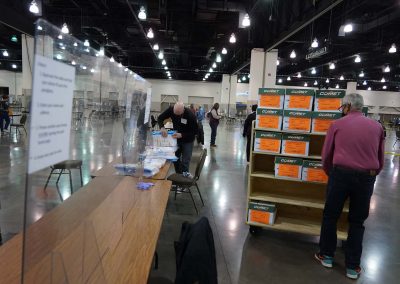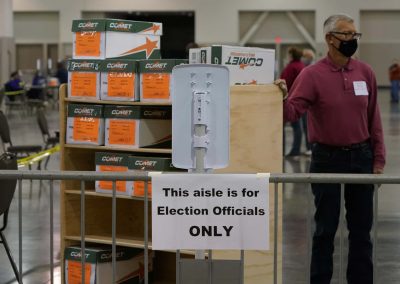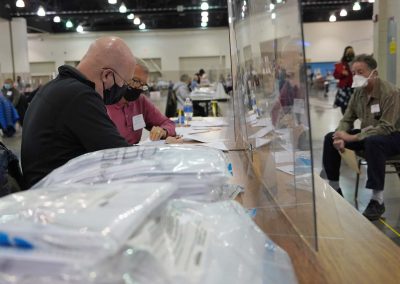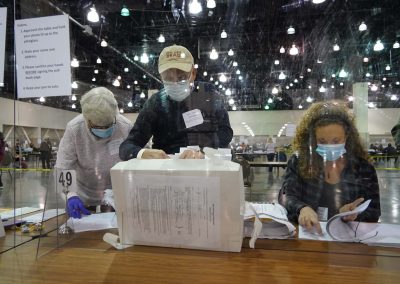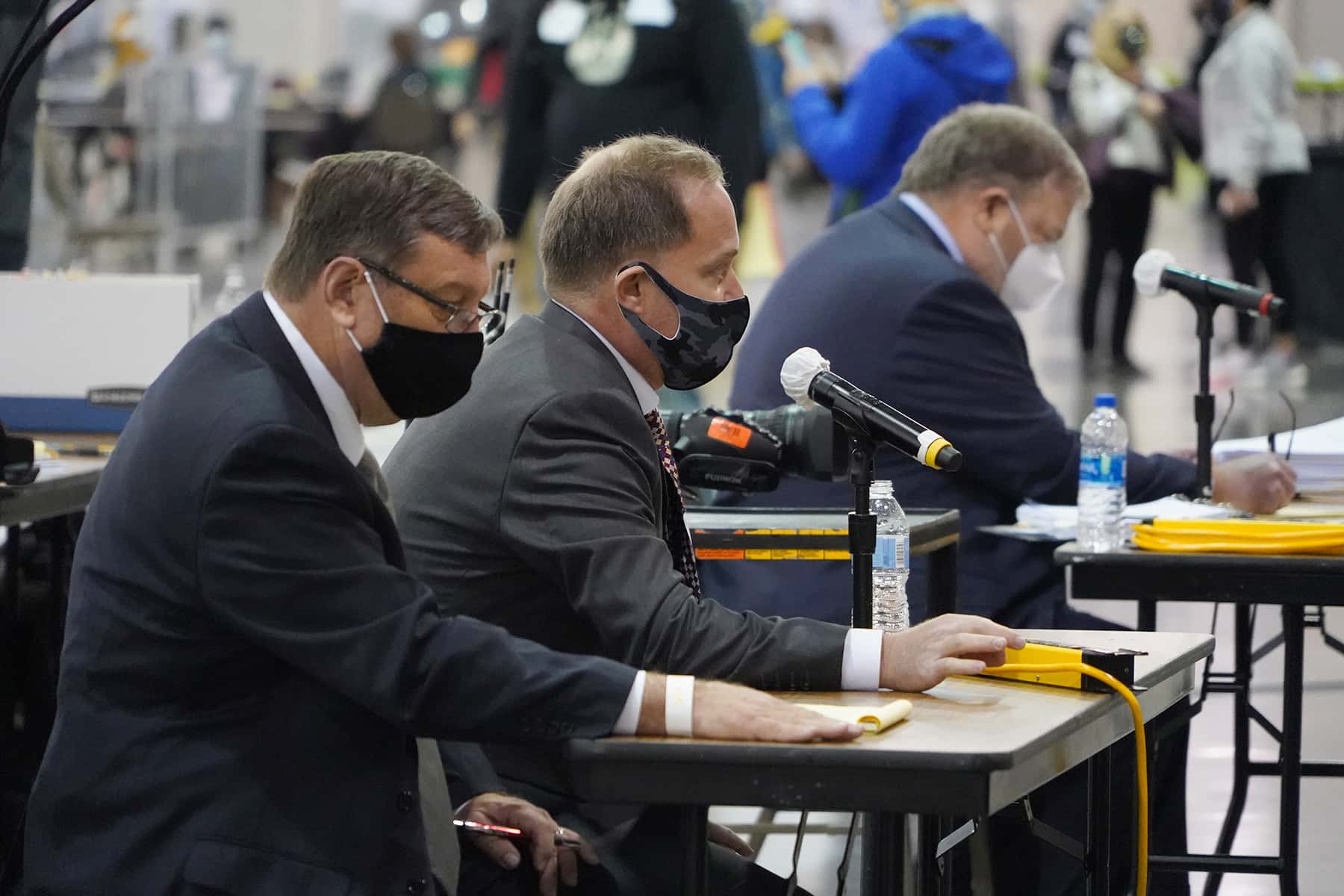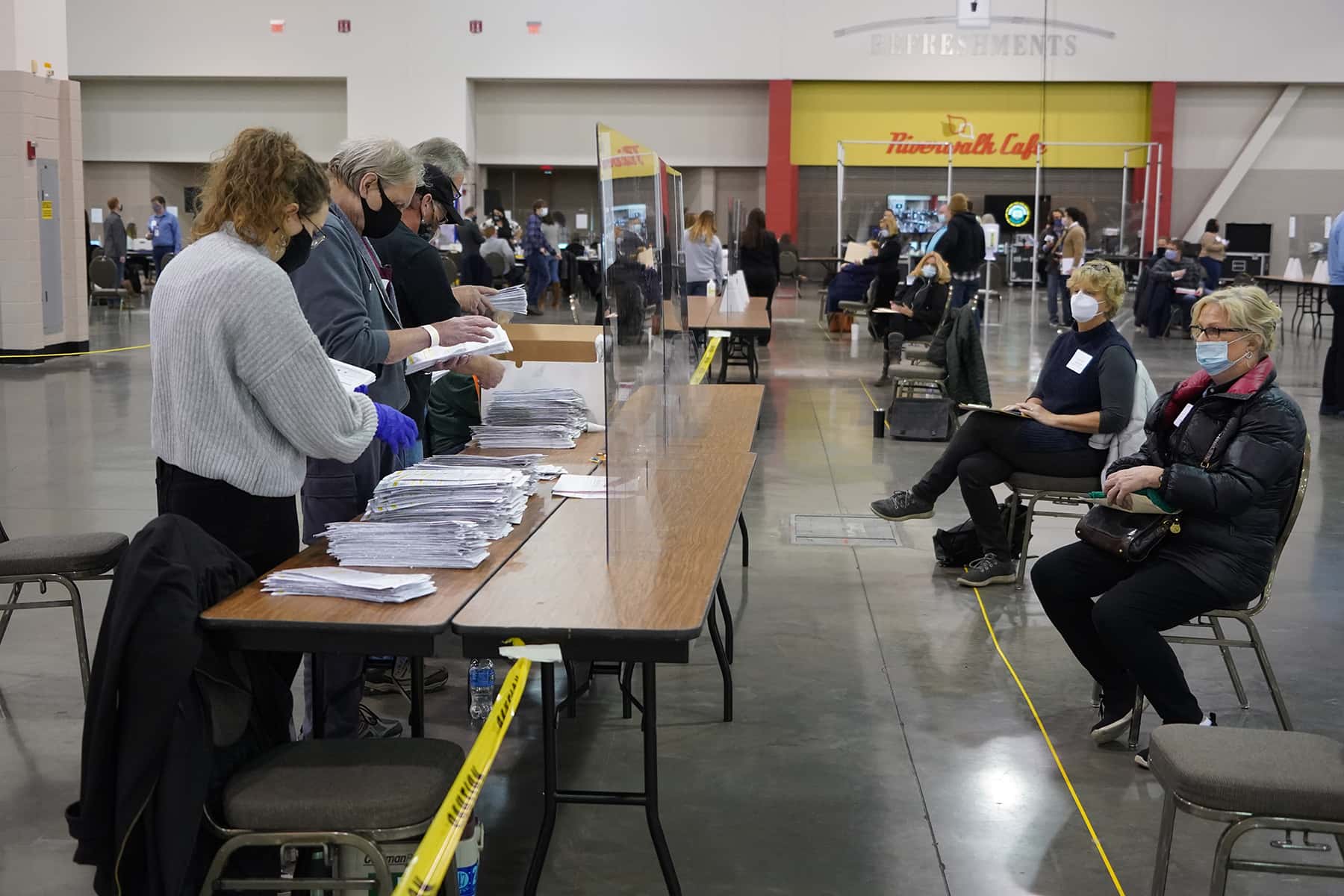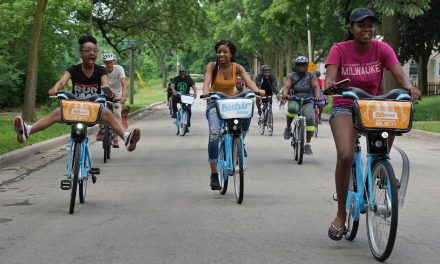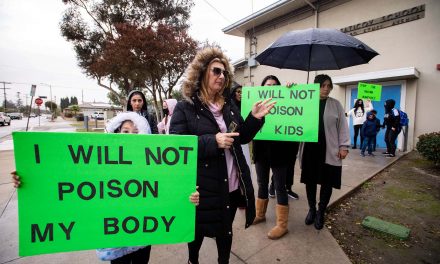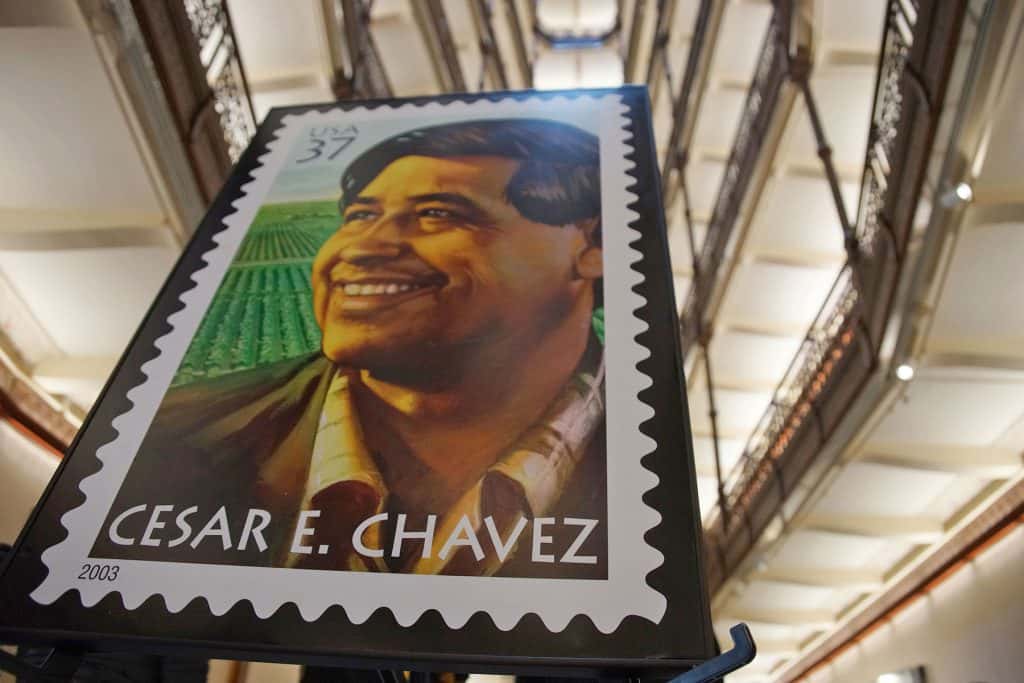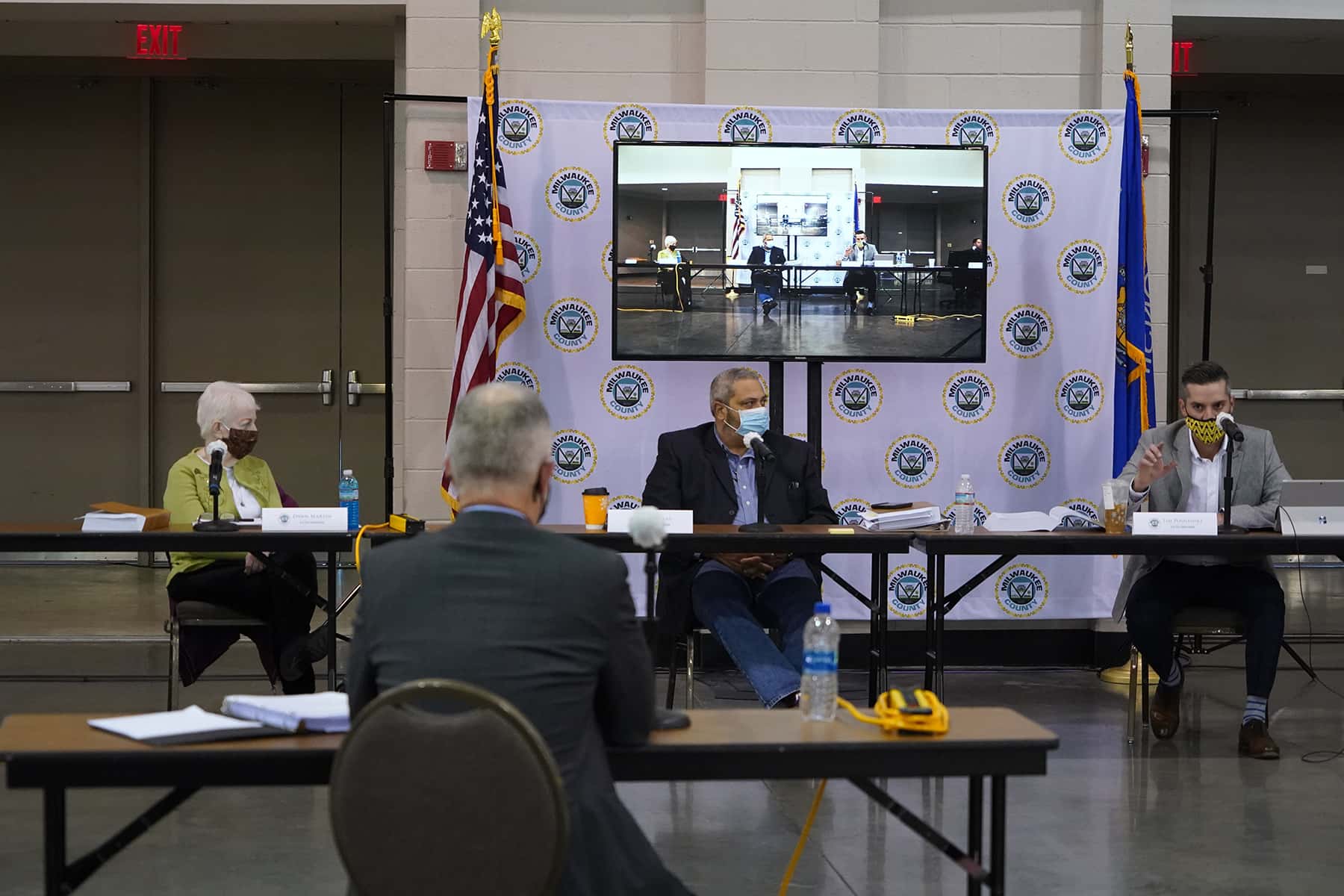
The president’s team wants to toss 170,000 in-person absentee ballots in Dane and Milwaukee counties, experts call the effort a long shot.
It may feel like 2016 all over again for some Wisconsin election officials: a presidential contender wins by about a 20,000-vote margin, there is a nearly even partisan divide and with Thanksgiving around the corner, workers are beginning a recount.
But this recount differs in one key respect. President Donald Trump’s campaign is not just looking for an accurate count of votes. The primary aim is to separate out and invalidate tens of thousands of ballots in two heavily Democratic counties that it claims were cast illegally — but in accordance with long-standing practice in Wisconsin.
In a petition filed on November 19, the Trump campaign accused Wisconsin election officials of illegally issuing absentee ballots to in-person voters without first requiring them to fill out an application, a challenge that could invalidate 170,000 votes in Dane and Milwaukee counties. The campaign is not challenging votes cast the same way in Wisconsin’s other 70 counties, including those where he won.
The petition also alleges that election officials illegally filled in the witness address portion of the envelope for some voters; and that they encouraged voters to indicate they are indefinitely confined as a way to circumvent photo ID requirements. Those are the claims at the center of the partial recount, a $3 million effort funded by the Trump campaign.
Those watching the Milwaukee count on November 21 reported wide-ranging objections by the Trump campaign, including an effort to exclude all folded ballots, which would mean all absentee ballots. Such arguments already have been rejected by Dane County’s three-member board, which includes two Democrats and one Republican.
Unofficial results show former Vice President Joe Biden won 75.5% of the vote in Dane County and 69.1% in Milwaukee County, beating Trump by 364,264 votes in the two counties combined. Statewide, Biden beat Trump by about 20,600 votes. Wisconsin’s 2016 statewide recount of the presidential vote changed the results by just 131 votes — in Trump’s favor.
“Over time and across the country, it has been rare for recounts to change margins by more than a few hundred votes, and 20,000 is virtually unprecedented,” according to Robert Yablon, who teaches election law at the University of Wisconsin Law School in Madison.
“The recount request may be a prelude to more litigation in Wisconsin by the Trump campaign, but given where things currently stand, such litigation would have little chance of success,” Yablon said in an email.
Nearly three dozen post-election lawsuits were lost or withdrawn by Trump and his allies. John Fortier, director of governmental studies at the Bipartisan Policy Center in Washington DC, said he doubts a court would disqualify so many votes.
“Why would a court throw out those ballots? You know, maybe they will tell officials they should do things better in the future,” said Fortier, who has written extensively about the Electoral College as well as absentee and early voting. “But, as a remedy, to throw the ballots out that people relied on in good faith, seems to me highly unlikely and arguably very unfair to voters who would not have known about this problem.”
Even if the recount does not affect the outcome of this election, some experts say it could change future ones.
“The Legislature may have some retrospective role to play,” said Jeffrey Mandell, a Wisconsin attorney focused on political and election law. “There’s been talks about doing some oversight hearings to look back at the election and think about what we learned about Wisconsin election law, and consider election law changes going forward.”
In-person absentee ballots under fire
The most consequential challenge is over the legality of in-person absentee ballots — those votes cast between Oct. 20 and November 1 at various drive-through or in-person polling places around the state. The petition claimed that these 170,000 voters in Dane and Milwaukee counties did not have to fill out a written application, which is required by law, to receive their ballots. The issue is what constitutes an application.
At the November 18 Wisconsin Elections Commission meeting, Administrator Meagan Wolfe stated that when absentee in-person voting takes place, the envelope itself — also known as the certificate — acts as the application.
“They fill out the ballot, they put it in the certificate envelope, and they fill out the information on the certificate envelope attesting to their qualification as elector and serving as their absentee ballot application,” Wolfe said. “So especially in the case of in-person absentee, it serves as not only the certification, but as the application for that voter as well.”
Michael Haas, the commission’s interim administrator in 2016 and now Madison’s city attorney, said the campaign also may be attempting to call into question Democracy in the Park, a Madison event where election workers accepted absentee ballots and helped voters register. The Madison city clerk said more than 10,000 ballots were dropped off in the first weekend of the event.
GOP state lawmakers sent a “cease and desist” letter to Madison’s clerk ordering her to shut down these events but did not pursue litigation. At the recount on November 20, Stewart Karge, a designated petitioner for the Trump campaign, reiterated the in-person absentee voting argument in the petition. Karge told elections officials at Milwaukee’s Wisconsin Center that according to state law, voters must submit an application before a ballot is issued.
Karge added that a voter applying for an absentee ballot in person at the clerk’s office must present proof of identification and that the clerk must verify the voter’s name and photograph. “None of that can happen if the application is on the envelope,” he said.
Can workers fill in witness addresses?
The Trump campaign alleges that election workers are violating state law by filling in witness addresses when they are missing from an absentee ballot envelope. The witness address is one of three fields on the front of the envelope. If a ballot is missing one of the other two — the voter signature or witness signature — it is rejected. But if it is missing the witness address, the Elections Commission has required clerks to fill in the field if they’re able to decipher the witness signature and find the address in the voter database.
“If clerks are reasonably able to discern any missing information from outside sources, clerks are not required to contact the voter before making that correction directly to the absentee certificate envelope,” the commission’s October 2016 memo read.
The memo cited concerns that clerks had about altering any information on the envelope, specifically if there were a recount. In response to those concerns, the commission advised clerks that they “must attempt to obtain any information that is missing from the witness address and document any addition by including their initials.” Often, clerks add this information in red ink.
Notably, the recommendation to fill in witness addresses was practiced in the 2016 election. It was supported by guidance from the Department of Justice, led by then-Attorney General Brad Schimel, a Republican.
In an often-contentious commission meeting on November 19, Republican commissioner Dean Knudson said it does not matter that this practice has been used in previous elections or was previously recommended by the commission. As it is now the subject of a legal challenge, he said, it should be examined.
“We are now in possession of a petition that constitutes a formal legal challenge to that guidance, a formal legal challenge to that practice,” Knudson said. “If the petitioner believes that something illegal happened, then that’s the basis to ask for the recount.”
Rep. Ron Tusler, R-Harrison, who chairs the Assembly’s Committee on Campaigns and Elections, agreed. Tusler said although clerks depend heavily on the commission’s guidance, the law will ultimately determine the state’s practices.
“What I suspect is that Trump’s team is going to go to the (state) Supreme Court and say, ‘Look, we’re not asking you to follow a recommendation …We’re asking you to follow state law,’ ” said Tusler, whose committee is investigating claims of voter fraud.
Mandell argues that because this guidance has been in place since 2016, was unanimously passed by the bipartisan Elections Commission and has not been questioned in 11 local, state and national elections, the Trump campaign should not take issue with it now.
“This is entirely a transparent partisan effort to gain advantage, because as long as they were happy with the election results, they were perfectly content to let this be the law,” he said.
As the recount began on November 20, Karge asked the Milwaukee County Board of Canvassers to set aside all ballots that have red or other colored ink different than the witness signature.
Who is ‘indefinitely confined?’
Another contention in the Trump campaign’s petition relates to so-called indefinitely confined voters. The commission’s guidance states “designation of indefinitely confined status is for each individual voter to make based upon their current circumstance.” State law allows voters to claim indefinitely confined status due to age, physical illness or infirmity or because they are disabled for an indefinite period.
Voters do not have to offer proof of their indefinitely confined status, but must mark it on the online or written ballot application. Dane County Clerk Scott McDonell advised voters in March to indicate they are indefinitely confined because of the pandemic when applying for an absentee ballot if they were having difficulty submitting a copy of their photo ID.
The commission strongly stated in guidance issued on March 29 that the indefinitely confined provision should not be used just as a means to avoid the photo ID requirement. On March 31, the state Supreme Court barred McDonell from making that recommendation. Clerks may contact voters to confirm their indefinitely confined status, according to Elections Commission guidance, “but they may not request or require proof.”
The number of indefinitely confined voters has risen sharply, from 56,978 in 2016 to 215,713 in 2020, Elections Commission figures show.
“It shouldn’t be a surprise that there were more indefinitely confined voters,” given the pandemic, Haas said. “Because that option has become more important to people, it was more publicized by maybe voter groups or campaigns.”
Tusler said the legal argument over this issue would be difficult to win — but not impossible. He said the Trump team’s strategy may be to subpoena documents — such as credit card records — from a sample of those voters to try to track their movements to disprove their indefinitely confined status.
On November 20, Trump petitioner Karge requested that all absentee ballot envelopes and absentee applications that identify indefinitely confined voters be set aside.
Verifying the results
On November 18, the Elections Commission held a special meeting to issue an order certifying the recount. Although debate turned contentious at times, the often-gridlocked body authorized the recount at the end of the marathon six-hour meeting. The recount involves retabulation of a municipality’s ballots, comparing polling site and absentee ballot logs and reviewing rejected ballots, Wolfe said during the meeting.
The recount must be completed within 13 days according to state law, which would be Dec. 1 in this case. The state commission must certify the results on that day, too. A three-person board of canvassers in each county, chaired by the county clerk, will recount the votes publicly. The boards in Dane and Milwaukee counties have both Democratic and Republican members.
Ballots can be challenged according to standards set forth by state law, said Mandell, and the board of canvassers may also decide whether to give credence to the objections raised in the Trump campaign’s petition. In the meantime, the boards of canvassers will have to decide on individual ballot challenges. If a ballot is deemed illegitimate — for example, because it was cast by someone under the age of 18 — it may be thrown out.
In most municipalities, an envelope with voter information cannot be matched back to its ballot. Therefore, if a vote is deemed illegitimate, a random ballot cast in that precinct will be “drawn down,” or tossed out, in order to make the numbers line up, Wolfe told reporters on November 19. She added that, in the city of Milwaukee, which counts absentee ballots at a Central Count location, envelopes are matched to ballots, so the specific illegitimate ballot can be thrown out.
Legal challenges loom
But the scope of the challenges raised in the Trump petition is vast. The question of the in-person absentee ballot application, for example, could conceivably invalidate every early vote cast in person.
“Absent some substantial legal ruling that would allow them to disqualify large numbers of ballots en masse,” like being able to throw out all early in-person absentee ballots, or one ballot for every envelope completed by a clerk, “they’re not going to be able to change the outcome of this election,” Mandell said.
But Rick Esenberg, founder and president of the conservative Wisconsin Institute for Law & Liberty, said legal challenges may arise from several directions. He cited a decision during the Florida recount of the 2000 George Bush vs. Al Gore election, which found that using different standards of ballot counting in different counties violated the Equal Protection Clause of the U.S. Constitution.
By challenging elections processes in only two dense, Democratic-leaning counties with large populations of non-white voters, the Wisconsin recount may end up holding voters in those counties to a different set of standards than elsewhere in the state, he said.
“That really could cut both ways here,” he added, “because if clerks in some counties followed the WEC guidance, but clerks in other counties did not, then that would create a discrepancy. At the same time, if clerks everywhere were following WEC guidance, and yet ballots only in Milwaukee and Dane counties are challenged, that could raise a challenge under Bush versus Gore.”
But he does not expect a conclusion like the dramatic 2000 decision in Florida — when Bush was declared the winner by a 537-vote margin after a contentious recount and legal battle.
Nora Eckert and Anya van Wagtendonk
The nonprofit Wisconsin Center for Investigative Journalism collaborates with Wisconsin Public Radio, Wisconsin Public Television, other news media and the UW-Madison School of Journalism and Mass Communication. All works created, published, posted or disseminated by the Center do not necessarily reflect the views or opinions of UW-Madison or any of its affiliates.
- Only two municipalities remain: Recount of Milwaukee County votes finally back on schedule
- Milwaukee's election recount proceeds smoothly but Trump campaign continues voter suppression tactics
- Ballot recounting finally moves forward on third day as Trump campaign seeks private voter data
- Trump targets Democratic strongholds in Wisconsin to toss out 170,000 in-person absentee ballots
- Milwaukee recount stumbles ahead as Trump campaign acts in bad faith by trying to reject every ballot
- Trump lawyers derail start of Milwaukee’s recount while his campaign observers intimidate poll workers

